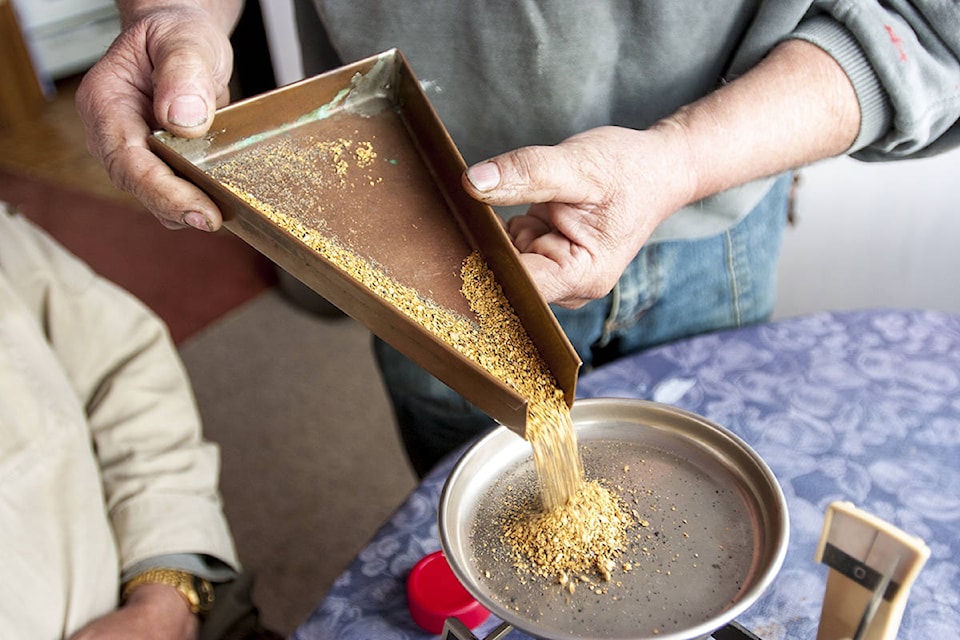A proposed gold mining project at Burwash Creek near Haines Junction could use a technique its proponent claims is new-to-the-Yukon and uses less water to extract more gold than traditional placer methods.
Traditional placer mining methods, which involve sluicing, use between 3,800 and 57,000 litres of water per minute, said Northern Minerals Development Incorporated (NMD) director Allan Falle. This new method, which is typically used in dry climates, will only use 606 litres of water per minute, he said, and will not require the use of a tailings pond.
Falle explained the method involves three 19,000 litre tanks, which use a centrifuge to separate gold and other metals from the water. The first two tanks do the separating, and the third is a holding tank, he said, and the water circulates around.
“By the time it gets to the second tank,” he said, “if you poured a glass of water out of it, you could see through it.”
Aside from using less water, Falle claimed the process will make remediation easier, because instead of putting the silt back and then placing the rock on top of it, the process allows the rocks to be put back first and then the silt placed on top of that. This silt layer makes it much easier for plants to take root and reclaim the mined area.
“The reclamation is so much easier,” he said. “You end up with a couple feet of good, rich topsoil and you have excellent regrowth.”
Environmental impacts aside, NMD has a good reason for wanting to implement this system, Falle said — traditional placer methods lose up to 85 per cent of the potential gold in the water, because it is so light and fine. This process can extract gold from water down to two microns.
“(Traditional placer mining) is throwing 80 to 85 per cent of the gold away — I choose not to,” Falle said. “Seventy to 85 per cent of the gold (in the water) is too light to be caught in a traditional sluice box. It’s just too light, it’s gone.”
Falle said that while it hasn’t been used in the North before, the proposed method will be effective.
“It’s a one stop process and it works,” he said. “This isn’t a new practice — it’s just that miners haven’t adopted it (in the Yukon).”
These methods are typically used by hard rock miners, he said. Falle said he isn’t doing anything truly new, only rearranging existing tools and techniques in a way that has not been applied in the Yukon before.
“It’s spending a little bit more upfront to get the rest of the gold out, make reclamation and keep the environment clean,” he said.
“There’s nothing hocus-pocus about it.”
Lewis Rifkind, mining analyst for the Yukon Conservation Society, said the YCS has some concerns.
“These new techniques, for lack of a better word, get hyped up,” Rifkind said.
“If this technique does work, given that it uses so little water, that’s kind of good, water contamination is one of the most difficult issues in mining. The less water you use, the less you contaminate… but the million dollar question, is does it work? And what kind of contingency plan do they have in place if it doesn’t?”
Rifkind said it will be difficult to determine how the method affects remediation until it is actually put in place.
“In my experience, whenever you dig something up and try to put it back in, you’ve always got something left over. What’s (this area) going to look like at the end?”
Additionally, there are some concerns regarding royalties around the project, Rifkind said, because not only does the method extract gold, but, according to the mining narrative submitted with the project’s Yukon Environmental Socio-Economic Assessment Board application, many other precious and non-precious metals.
“NMD’s concentrates will contain virtually all the precious and non-precious metals, including the magnetic cut, plus any sulfides that are exposed,” the application reads.
Some of those metals will fall under the Placer Miner Act, others under acts such as the Quartz Mining Act, and how royalties, both to the Yukon government and to Kluane First Nation — on whose Class A traditional territory the proposed site would sit— is questionable, said Rifkind.
“Anytime you withdraw any metals from the ground, you owe YG and the First Nations money,” he said. “How do we know what the royalties are going to be? What regulations apply here?”
While the effectiveness of the method has yet to be proven, Rifkind said it seemed to him as if it is more efficient, in terms of extraction potential.
“This bed has been worked over in the past… you may as well get everything you can out if you’re going to destroy the stream bed again,” Rifkind said. “It’s like going hunting. You might as well eat everything right down to the moose’s nose if you’ve already destroyed the moose.”
The proposed project is currently before YESAB for assessment. It is open for public comment until Sept. 5.
Contact Lori Garrison at lori.garrison@yukon-news.com.
